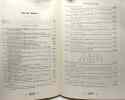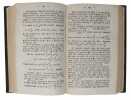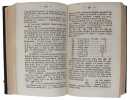-
Type
Book (19880)
Magazine (13)
Manuscript (4)
Maps (1)
Photographs (4)
-
Latest
Last 24h (3)
Last 3 days (3)
Last month (28)
Last week (6)
-
Language
English (43)
French (19848)
German (2)
Japanese (1)
Latin (1)
Polish (2)
Portuguese (1)
Russian (1)
Spanish (1)
Swedish (2)
-
Century
16th (6)
17th (37)
18th (303)
19th (3730)
20th (11875)
21st (1527)
-
Countries
Belgium (361)
Brazil (1)
Côte d'Ivoire (19)
Denmark (1354)
France (18009)
Switzerland (158)
-
Syndicate
ILAB (17294)
NVVA (26)
SLACES (26)
SLAM (15914)
SNCAO (12)
MATHS - EXOS + - 1ERE S - PLUS DE 300 EXERCICES - DES QCM - DES RAPPELS DE COURS - TOUS LES CORRIGES - MEMOBAC
BORDAS. 2007. In-8. Broché. Bon état, Tâchée, Dos satisfaisant, Intérieur frais. 509 Pages. Nombreuses figures en noir et blanc dans et hors texte. 1er plat taché.. . . . Classification Dewey : 372.7-Livre scolaire : mathématiques
Classification Dewey : 372.7-Livre scolaire : mathématiques
MEMO BAC, MATHS OBLIGATOIRE ET SPECIALITE, TERMINALES ES
Bordas. 2007. In-8. Broché. Bon état, Couv. légèrement pliée, Dos satisfaisant, Intérieur frais. 288 pages.. . . . Classification Dewey : 372.7-Livre scolaire : mathématiques
Exos +. PLus de 170 exercices. Des QCM. Les corrigés... Classification Dewey : 372.7-Livre scolaire : mathématiques
BOISSIERE G., BRABANT P., WEINSANTO L.
Reference : RO60023123
(1999)
ISBN : 2040287302
MATHS 1re ES, OBLIGATOIRE & OPTION
Bordas. 1999. In-4. Broché. Etat d'usage, Couv. défraîchie, Dos satisfaisant, Mouillures. 368 pages. Illustré de nombreuses figures géométriques. Coins des premières pages retournés.. . . . Classification Dewey : 372.7-Livre scolaire : mathématiques
Fractale. Sous la dir. de G. Bontemps. Classification Dewey : 372.7-Livre scolaire : mathématiques
Flash : Analyse Mathématique DEUG Sciences économiques et AES Tome 1 : Résumés de cours - Exercices et problèmes corrigés
Armand Colin. 1993. In-8. Broché. Bon état, Couv. convenable, Dos satisfaisant, Intérieur frais. 158 pages. . . . Classification Dewey : 510-Mathématiques
2ème édition. Classification Dewey : 510-Mathématiques
Mathématiques de l'informatique - Tome 1
Dunod , Université et Technique Malicorne sur Sarthe, 72, Pays de la Loire, France 1969 Book condition, Etat : Bon broché grand In-8 1 vol. - 135 pages
1ere édition Contents, Chapitres : Avant-propos, table x, texte, 125 pages - Arithmétique appliquée - Définition d'un ensemble - Algèbre de Boole - Pratique du calcul binaire - Exercices portant sur l'algèbre de Boole papier legerement jauni, sinon bon etat - tome 1 seul
Maths sciences physiques - Terminale ST2S -
Ellipses. 2009. In-8. Broché. Bon état, Couv. convenable, Dos satisfaisant, Intérieur frais. 410 pages.. . . . Classification Dewey : 372.7-Livre scolaire : mathématiques
"collection ""controle continu"" Classification Dewey : 372.7-Livre scolaire : mathématiques"
Scientific Truth and Statistical Method. Translated from the Italian by Ruth Kendall.
London, (1972). Orig. full cloth with dustjacket. XIV,264 pp. and portrait.
First English edition.
La perspective expliquée.
Etienne Chiron. non daté. In-12. Broché. Etat d'usage, Couv. convenable, Dos satisfaisant, Quelques rousseurs. 72 pages - nombreuses figures en noir et blanc dans et hors texte - 2 planches en couleurs dépliantes - tampon sur la page de faux titre - annotation sur la page de titre - papier jauni.. . . . Classification Dewey : 510-Mathématiques
Classification Dewey : 510-Mathématiques
La chance et les jeux de hasard - Loterie, boule, roulettes, baccara, 30 et 40, dés, bridge, poker, belote, écarté, piquet, manille (Reprint 1992 de l'édition Larousse de 1948)
Editions Jacques Gabay (Larousse) , Oblong Malicorne sur Sarthe, 72, Pays de la Loire, France 1992 Book condition, Etat : Très Bon broché, sous couverture imprimée éditeur blanche In-4 oblong 1 vol. - 382 pages
155 figures dans le texte et 108 tableaux reprint 1992 de l'édition de 1948 Contents, Chapitres : Introduction - Qu'entend-on par probabilités - Curiosités mathématiques - Le jeu de pile ou face, parties courtes, la fin des longues parties, les péripéties des longues parties, les martingales ou la ruine des joueurs - Les dés - Le poker d'as - Loterie et sweepstake - La boule, chances simples, numéros pleins, le jeu des avions - La roulette, chances simples, chances multiples et double roulette - Le trente et le quarante - Le baccara, conditions préliminaires, tactique du ponte, riposte du banquier - Les jeux de pur hasard - L'écarté - La belote - Quelques autres jeux - Le poker - Le bridge - Les jeux de semi-hasard - La chance et sa destinée bel exemplaire, tres frais - Texte sur 2 colonnes, format oblong
LE MYSTERE DES NOMBRES & DES FORMES - NOMBRES REELS ET COMPLEXES - FORMES NATURELLES ET ARTIFICIELLES - DIAGRAMMES DESCRIPTIFS DU MONDE MATERIEL ET DES FAITS HUMAINS.
LAROUSSE. 1941. In-8. Broché. Etat d'usage, 2ème plat abîmé, Dos abîmé, Intérieur frais. 329 pages - nombreuses gravures en noir et blanc dans et hors texte - plats desolidarisés - dos partiellement manquant.. . . . Classification Dewey : 510-Mathématiques
Classification Dewey : 510-Mathématiques
Le Mystère des nombres & des formes.
LAROUSSE. 1944. In-12. Broché. Bon état, Couv. légèrement passée, Dos satisfaisant, Intérieur frais. 329 pages. Nombreux schémas et croquis en noir et blanc dans le texte. Pages non coupées. Charnière fendue en coiffes.. . . . Classification Dewey : 510-Mathématiques
Nombres réels et complexes, formes naturelles et artificielles, Diagramme descriptifs du monde matériel et des faits humains. Classification Dewey : 510-Mathématiques
LES CERTITUDES DU HASARD
1966 broché in-octavo tellière, dos blanc, couverture rose, illustrations : figures in-texte, surlignage, 128 pages, 1966 Paris Presse Universitaires de France,
Collection "Que Sais-Je ?" numéro 3, neuvième édition, bon état
Les certitudes du hasard. Collection : Que Sais-je?, N°3.
Paris, Presses Universitaires de France, PUF, 1958. 11 x 17, 127 pp., broché, bon état (couverture défraîchie).
Les mystères des nombres & des formes - Nombres réels et complexes formes naturelles et artificielles diagrammes descriptifs du monde matériel et des faits humains.
Larousse. 1941. In-8. Broché. Etat d'usage, Couv. convenable, Coiffe en pied abîmée, Papier jauni. 329 pages - nombreuses figures en noir et blanc dans le texte.. . . . Classification Dewey : 510-Mathématiques
Classification Dewey : 510-Mathématiques
L'idée générale de la Mécanique ondulatoire et de ses premieres applications. Atome d'hydrogène, phénomènes chimiques, conduction électrique.
1932 in-12, 74pp., br. P. Hermann 1932,
Phone number : 33 (0)6 77 77 12 33
Que sais-je? N° 3 Les certitudes du hasard
Presse Universitaires de France Edition originale Première édition 9 juin 1941. 1941. In-12. Broché. Bon état, Couv. convenable, Dos satisfaisant, Intérieur frais. 128 pages illustrées de quelques dessins en noir et blanc. . . . Classification Dewey : 510-Mathématiques
La première encyclopédie de poche fondée en 1941 par Paul Angoulvent, traduite en 43 langues, diffusée, pour les éditions françaises, à plus de 160 millions d'exemplaires, la collection Que sais-je? est l'une des plus importantes bases de données internationnales, construite pour le grand public par des spécialistes. 3800 titres ont été publiés depuis l'origine par 2500 auteurs. Classification Dewey : 510-Mathématiques
Que sais-je? N° 42 Histoire des mathématiques
Presses Universitaires de France. 1968. In-12. Broché. Bon état, Couv. convenable, Dos satisfaisant, Intérieur frais. 128 pages illustrées de quelques dessins en noir et blanc. . . . Classification Dewey : 510-Mathématiques
La première encyclopédie de poche fondée en 1941 par Paul Angoulvent, traduite en 43 langues, diffusée, pour les éditions françaises, à plus de 160 millions d'exemplaires, la collection Que sais-je? est l'une des plus importantes bases de données internationnales, construite pour le grand public par des spécialistes. 3800 titres ont été publiés depuis l'origine par 2500 auteurs. Classification Dewey : 510-Mathématiques
Que sais-je? N° 42 Les étapes des mathématiques
Presses Universitaires de France 2ème édition. 1942. In-12. Broché. Bon état, Couv. convenable, Dos satisfaisant, Intérieur frais. 128 pages illustrées de quelques dessins en noir et blanc. . . . Classification Dewey : 510-Mathématiques
La première encyclopédie de poche fondée en 1941 par Paul Angoulvent, traduite en 43 langues, diffusée, pour les éditions françaises, à plus de 160 millions d'exemplaires, la collection Que sais-je? est l'une des plus importantes bases de données internationnales, construite pour le grand public par des spécialistes. 3800 titres ont été publiés depuis l'origine par 2500 auteurs. Classification Dewey : 510-Mathématiques
Tables numériques universelles des laboratoires et bureaux d'étude
Dunod 1957 in4. 1957. Broché.
Bon Etat de conservation couverture ternie défraîchie intérieur propre
La conquête de la vérité.
Editions du Sablon. 1947. In-12. Broché. Bon état, Couv. convenable, Dos satisfaisant, Non coupé. 280p. 42 illustrations en noir et blanc.. . . . Classification Dewey : 510-Mathématiques
Récit simplifié des derniers progrès de la logique scientifique. Classification Dewey : 510-Mathématiques
"BOLLÉE, LÉON. - THE INVENTION OF ""THE MILLIONAIRE CALCULATOR""
Reference : 48744
(1889)
Sur une nouvelle machine à calculer.
(Paris, Gauthier-Villars, 1889). 4to. No wrappers. Disbound. In: ""Comptes Rendus Hebdomadaires des Séances de L'Academie des Sciences"", Tome 109, No 20. Pp. (723-) 758 (entire issue offered). Bollée's paper: pp. 737-739. Disbound but clean.
First printing of the paper in which Bollée describes his invention of a new calculating machine, later called ""The Millionaire"", based on a multiplying mechanism which was capable of performing multiplication directly instead of using repeated addition. As it allows multiplication by any digit it was used by government agencies ans scientists, especially astronomers, well into the twentieths century.Bollée did not produced his machine comercially, ""... but in 1893 Otto Steiger of Munich patented a calculator based on Bollée's approach, which was manufactured between 1895 and 1935 by the firm Hans W. Egli of Switzerland and marketed under the name of ""Millionaire"".... Forty-six hundred ""Millionaires"" were sold, primarly in Europe."" (Hook & Norman ""Origins of Cyberspace"" : 288).
Über die Integrale linearer Differentialgleichungen mit periodischen Coëfficienten.
Wien, Karl Gerold's Sohn, 1868. 8vo. Uncut and unopened in orig. printed wrappers. In: ""Sitzungsberichte der kaiserlichen Akademie der Wissenschaften"", 58. Band, 1. Heft - Juni. Pp. (1-) 155 a. 7 plates.(Entire issue offered). Boltzmann's paper: pp. 54-59. Clean and fine.
First apperance of an importent paper in which Boltzmann from a mathematical point of view defends atomism. ""Throughout his career, even in his works on subjects other than kinetic theory Boltzmann was concerned with the mathematical problems arising from the atomic nature of matter. Thus, an early paper with the title ""Über die Integrale linearer Differentialgleichungen mit periodischcn Koeffizienten"" (1868) turned out to be an investigation of the validity of Cauchy’s theorem on this subject, which is needed to justify the application of the equations for an elastic continuum to a crystalline solid in which the local properties vary periodically from one atom to the next."" (DSB). The issue contains an importent paper by JOHANN JOSEPH LOSCHMIDT ""Ableitung des Potentiales bewegter elektrischer Massen aus dem Potentiale für die Ruhestand"", pp. 7-14, in which he attempted to derive the Weber-Ampère law from that of Coulomb, and, in accordance with Kirchhoff, to derive Ohm’s law from hydrodynamic flow laws, analogous to Poiseuille’s law.
A’ Marosvasarhelyt 1829-be nyomtatott Arithemetika Elejének részint röviditett, reszint bovitett, általán jobbitott, ‘s tisztáltabb kiadása. - [BOLYAI'S LAST MAJOR WORK]
Marosvásárhely, Kali Simon, 1843. 8vo. In a simple contemporary half calf with gilt ornamentation to spine forming five compartments. Later paper title-label with gilt lettering pasted on to spine, partly detached in right margin. Light wear to extremities. Stamp to front free end-paper. First leaves evenly lightly browned. An overall fine and clean copy. XLIV, 386 pp. + 2 folded plates, one with 12 folding flaps with partial grey colouring.
The rare first edition of Bolyai’s important work on the foundations of mathematics, being his last major work. It is in part based on his ‘Az arithmethica eleje’ (1830), in many aspects a rudimentary and introductory work, and the second volume of his magnum opus ‘Tentamen juventutem studiosam elementa matheseos purae’ (1832-33) – but here, for the first time, expanded and fully expounded. As with Bolyai’s other works, it was unappreciated by his contemporaries: “He can be taken as a precursor of Gottlob Frege, Pasch, and Georg Cantor" but, as with many pioneers, he did not enjoy the credit that accrued to those that followed him” (DSB). His work was considered mathematically incomprehensible by his colleagues and only his students and his son, János Bolyai, understood and appreciated it. Probably because of lack of interest from Bolyai’s contemporaries, all of his works are now rare, the present work being no exception. It has appeared only once at auction the past 30 years.In 1796, Farkas Bolyai (1775-1856) traveled to Germany, first to Jena and then to Göttingen, where he studied until 1799. It was at this time that Bolyai began his lifelong friendship with Carl Friedrich Gauss, also a student at the University Göttingen, who was already intensely engaged in mathematical research. Bolyai’s interest in the foundations of geometry dates from this period, especially in the so-called Euclidean or parallel axiom, to which Kastner and Seyffer, as well as Gauss were devoting their attention. Bolyai maintained a correspondence with Gauss that, with interruptions, lasted all their lives. Bolyai accepted the position of professor of mathematics, physics, and chemistry at the Evangelical-Reformed College at Marosvásárhely in 1804, where he taught until his retirement in 1853. Meanwhile, he continued his research, concentrating on the theory of parallels. He sent a manuscript on this subject, Theoria parallelarum, with an attempt to prove the Euclidean axiom, to Gauss in 1804. The reasoning, however, satisfied neither Gauss nor himself, and Bolyai continued to work on it and on the foundations of mathematics in general. “In 1829 Bolyai finished his principal work, but because of technical and financial problems it was not published until 1832–1833. It appeared in two volumes, with the title Tentamen juventutem studiosam in elementa matheseos purae, elementaris ac sublimioris, method intuitiva, evidentiaque huic propria, introducendi, cum appendice triplici (“An Attempt to Introduce Studious Youth Into the Elements of Pure Mathematics, by an Intuitive Method and Appropriate Evidence, With a Threefold Appendix”). While writing the Tentamen, Bolyai had his first difficulties with his son János. In spite of warnings from his father to avoid any preoccupation with Euclid’s axiom, János not only insisted on studying the theory of parallels, but also developed an entirely unorthodox system of geomentry based on the rejection of the parallel axiom, something with which his father could not agree. However, despite misgivings, Bolyai added his son’s paper to the first volume and thus, unwittingly, gave it immortality. In 1834, a Hungarian version of Volume I was published. The Tentamen itself, the fundamental ideas of which may date back to Bolyai’s Göttingen days, is an attempt at a rigorous and systematic foundation of geomentry (Volume I) and of arithmetic, algebra, and analysis (Volume II). The huge work shows the critical sprit of a man who recognized, as did few of his contemporaries, many weaknesses in the mathematics of his day, but was not able to reach a fully satisfactory solution of them."" (DSB) Neverthless, when it is remembered that Bolyai worked in almost total isolation, his works are a most remarkable witness to the sharpness of his mind and to his perseverance. Not in Sommerville
Briefwechsel zwischen Carl Friedrich Gauss und Wolfgang Bolyai.
Leipzig, T.B. Teubner, 1899. 4to. Original half calf with gilt spine lettering. XII,(4),208 pp. and numerous facsimiles.
Appendix. Scientiam Spatii Absolute Veram exhibens: a veritate aut falsitate Axiomatis XI Euclidei (a priori haud unquam decidenda) independentem: adjecta ad casum falsitatis, quadratura circuli geometrica. - [THE ABSOLUTELY TRUE SCIENCE OF SPACE]
Budapest, Hungarian Academy of Sciences, 1904. This is a reprint of the second volume the second edition of Farkas Bolyai's 'Tentamen', which conatined János Bolyai's discovery of non-Euclidean geoemtry as an appendix (pp.359-394 and 7 plates).
Unabridged reprint of János Boyai's famous appendix to his fathers treatise in which he first announced his discovery of non-Euclidean geometry.
 Write to the booksellers
Write to the booksellers















